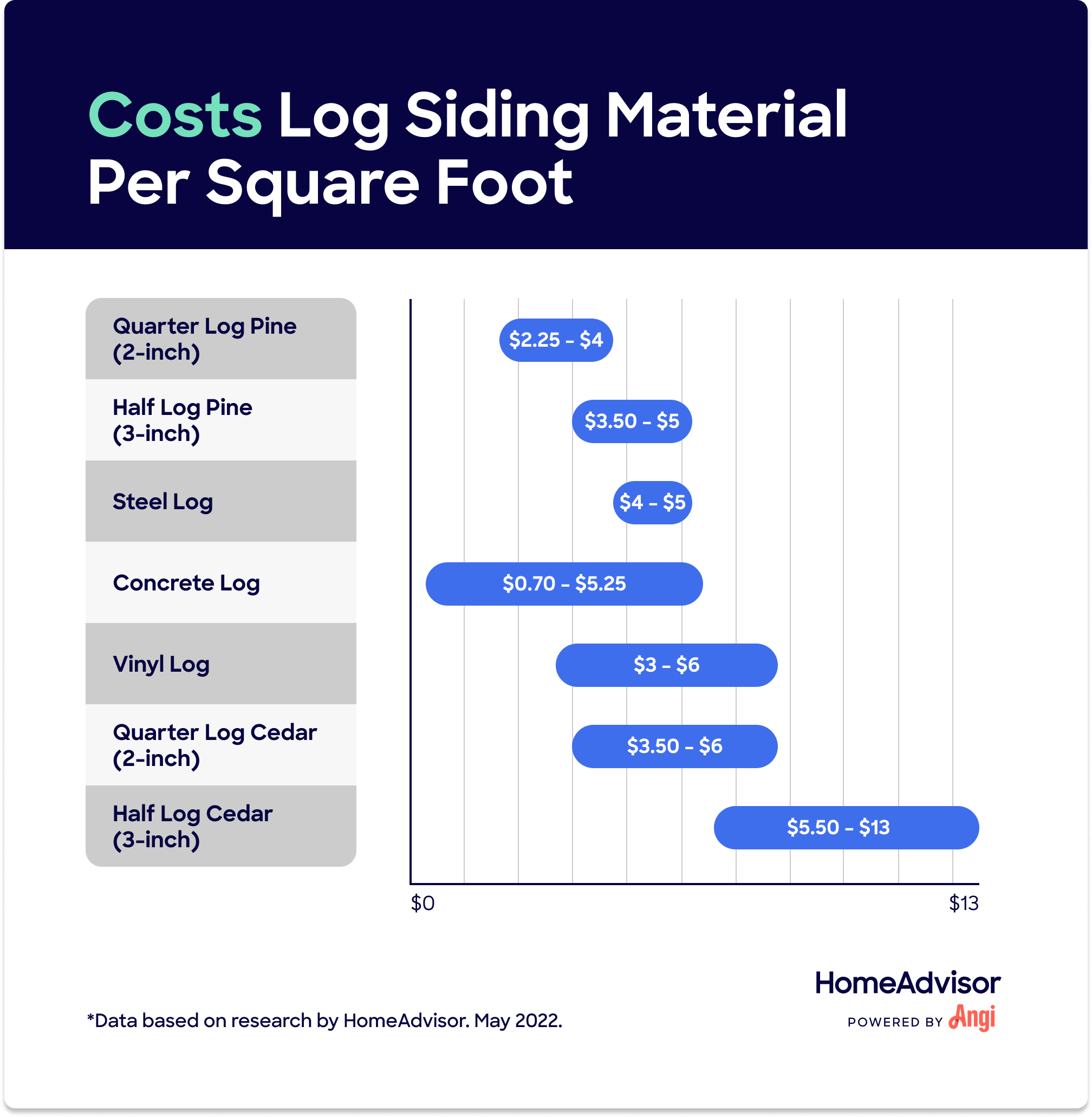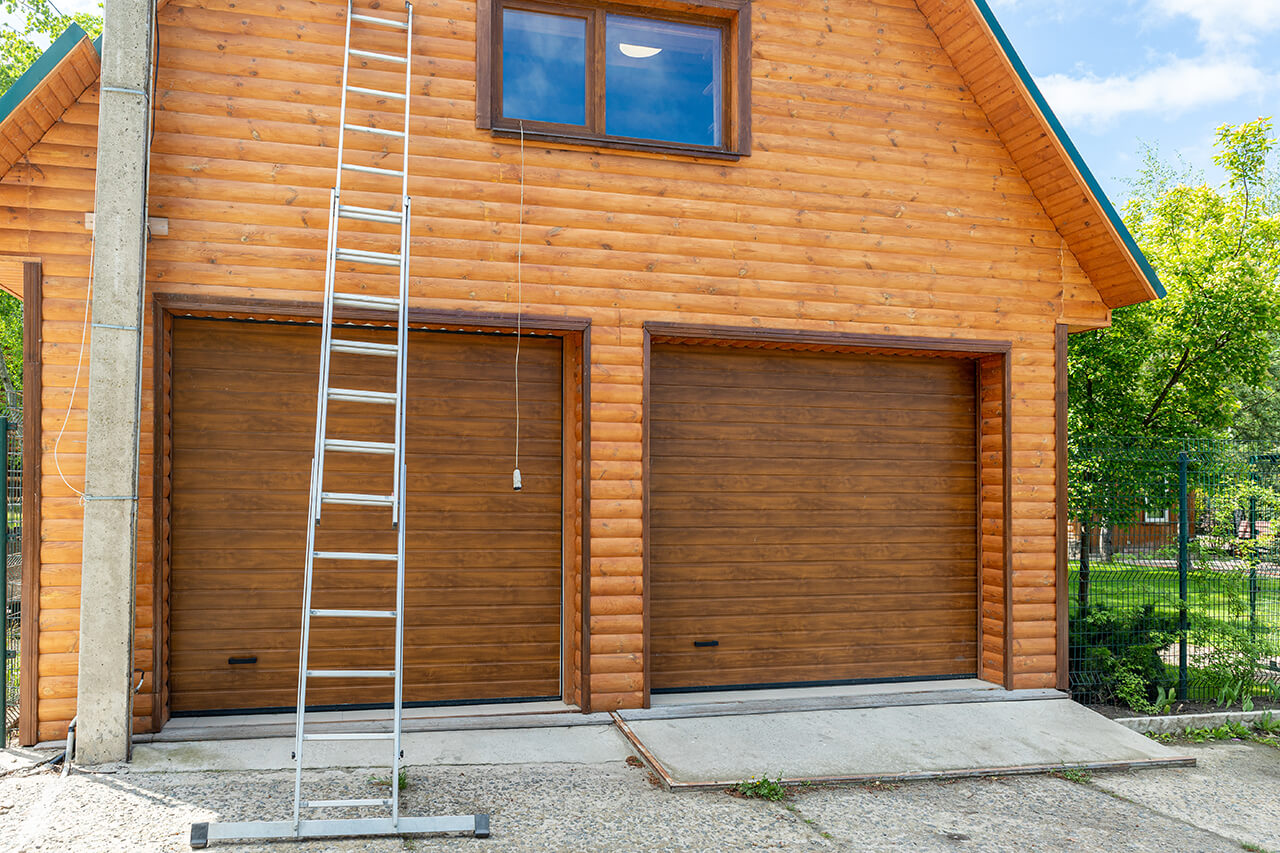How Much Does Log Siding Cost?
Typical Range:
$5,625 - $32,500
Typical Range:
$5,625 - $32,500
Cost data is based on research by HomeAdvisor.
Updated June 3, 2022
Written by HomeAdvisor.Overall, log siding costs an average of $6.25 per square foot without factoring in professional labor or other construction factors. This price typically ranges between $2.25 per square foot and $13 per square foot depending on the type of wood and the thickness of the material. It costs an average of $15,625 to install log siding on a 2,500-square-foot-home, for materials alone.
2022 Notice: Material Prices Are Surging
Demand for siding and other building materials has grown over the past year. And as a result, manufacturers are increasing materials prices. Prices have gone up 5% to 10% this year, and many parts of the country are experiencing long delivery times. If you're planning a building project, we recommend starting as early as possible in the season, preparing for potential price fluctuations, and allowing extra time to order materials.
Expect to pay anywhere between $2.25 and $13 per square foot on log siding. The total material cost of log siding alone, not including labor, for the typical 2,500-square-foot home would be between $5,625 and $32,500.
Keep in mind that log siding costs will vary depending on the type and quality of the material chosen. For example, log siding typically comes in either pine or cedar in thicknesses of two or three inches, each of which comes in at a different price point.
Log siding is traditionally made from pine, which averages $2.25 to $4 per square foot for two-inch quarter log planks or $3.50 to $5 per square foot for three-inch half log planks. Traditional wood log siding gives your home the timeless look of a log cabin home with unique natural wood knots and grains at up to 50% savings compared to full logs.
Expect to pay more for kiln-dried logs, which are pre-shrunk to avoid warping, shrinking, and settling after installation. Other maintenance costs include required regular staining and finishing as well as repair costs due to water, mold, moss, or insect damage.
Cedar log siding costs more than traditional wood, at $3.50 to $6 per square foot for two-inch quarter log planks or $5.50 to $13 per square foot for three-inch half log planks. You still get the authentic look and smell of a log cabin, ideal for a lodge-style home. You’ll pay more for factory finished or kiln-dried logs, though these will also reduce your regular maintenance costs.
Vinyl log siding materials cost $3 to $6 per square foot. This affordable alternative creates a log cabin look without the added costs of maintaining authentic wood, since vinyl resists rot, mold, insects, and mildew. It can also be safely power-washed and requires no additional treatment or finishing. Since vinyl is not a good insulator, you may pay more in utility costs.
Steel logs for siding cost $4 to $5 per square foot, though the market price of metal siding often fluctuates. Made to look like natural logs, this premium material is a highly durable, easy to maintain, and fire-resistant alternative to natural timber.
Also called fiber cement logs, concrete log siding costs $0.70 to $5.25 per square foot, depending on the quality of the material. This alternative is competitive with natural timber in both look and price, offering easier maintenance, durability, and resistance to fire, mold, insects, rot, and moss. It may come with higher installation costs due to its fragility and heavy weight.
Different log siding materials have different installation and maintenance requirements that will impact your total costs. For example, natural wood needs to be sealed on all sides before installation and refinished regularly post-installation to protect it from moisture.
Other factors that impact the cost of your wood log siding include:
Wood type: There are several pine and cedar species available for log siding. Pine is less expensive than cedar, though it won’t last as long and isn’t as damage-resistant.
Wood grade: Grade has to do with the quality and appearance of the wood, and includes a few different choices such as knotty pine.
Air-dried vs. kiln-dried: Partially air-dried log siding costs less than kiln-dried siding.
Siding profile: The thicker the siding, the higher cost you’ll pay.
If you intend to cover all exterior walls of your home with log siding, the size of your home will directly impact total project cost. Increased property size means an increase in the amount of material you’ll need to purchase, as well as the time it will take your contractor to complete installation.
Natural wood log siding needs to be finished to protect it from moisture. Prefinished pine and cedar siding is primed or stained and sealed on all sides at the factory, leading to slightly higher upfront material costs compared to unfinished bare siding. However, purchasing prefinished siding saves you up to 50% compared to the cost of having the work done onsite to bare siding.
Prep work typically involves the removal and disposal of old siding, which can add up to $3 per square foot to your total costs. Even if you do this work DIY, you’ll likely need to rent a dumpster for disposal. Contractors may include the cost of a dumpster rental in your overall removal cost. Dumpster rental costs $380 on average.
Depending on your local regulations, you may need to pay the cost to get a building permit from your local government to change the material of your siding. These costs will vary from city to city, but expect to pay anywhere from $447 to $2,313.
Log siding allows homeowners to spend significantly less compared to building a traditional timber home, in some cases. Full logs average $4.30 per square foot. Using eco-friendly alternatives like half or quarter logs allows you to save up to 45%, depending on the type of wood you choose. We break down the typical cost range for each log type below.
Full log siding costs an average of $4.30 per square foot. Full logs can be 8, 10, or 12 inches thick, and will be visible from both the interior and exterior of the home. They are typically installed when the home is first built, and don’t require separate framing or different interior wall surfaces. This can keep the cost to install full logs lower than quarter or half logs in some cases.
Half log pine siding is priced between $3.50 and $5 per square foot. Cedar half logs cost $5.50 to $13 per square foot. At 3 inches thick, half logs require only half the amount of wood of traditional logs, but create the same visual log home façade.
Quarter log pine costs $2.25 to $4 per square foot, while cedar alternatives cost between $3.50 and $6 per square foot. At two inches thick, quarter logs are even better for the environment, using 75% less wood than full logs. They can be installed using conventional frame construction, and are light enough to be easily used in a DIY project.
Log siding installation can be done as a DIY project when you have the right tools and expert construction experience. You’ll also need to acquire building permits and assemble a crew of multiple people to help you lift each piece of siding and ensure it’s perfectly level. Improper installation can lead to costly damage down the line.
You can ensure a safe and proper installation as well as easier future maintenance if you hire a siding proto handle the job for you. When choosing a contractor, make sure they are licensed, bonded, and insured with a good local reputation and positive reviews.
You can choose from a variety of affordable alternatives to natural wood log siding:
| Alternatives to Natural Wood Log Siding | Cost Per Square Foot |
|---|---|
| Vinyl Log Siding | $3 – 6 |
| Steel Logs | $4 – $5 |
| Concrete or FIber Cement Logs | $0.70 – $5.25 |
Each is designed to mimic the look and texture of natural timber, but with added durability and resistance to damage from moisture and insects.
Vinyl log siding is not more expensive than other types of vinyl siding. At an average of $4 per square foot, vinyl log siding is actually on the lower end of vinyl siding costs, with vinyl shake, insulated vinyl, and vertical vinyl all coming in at higher price points.

